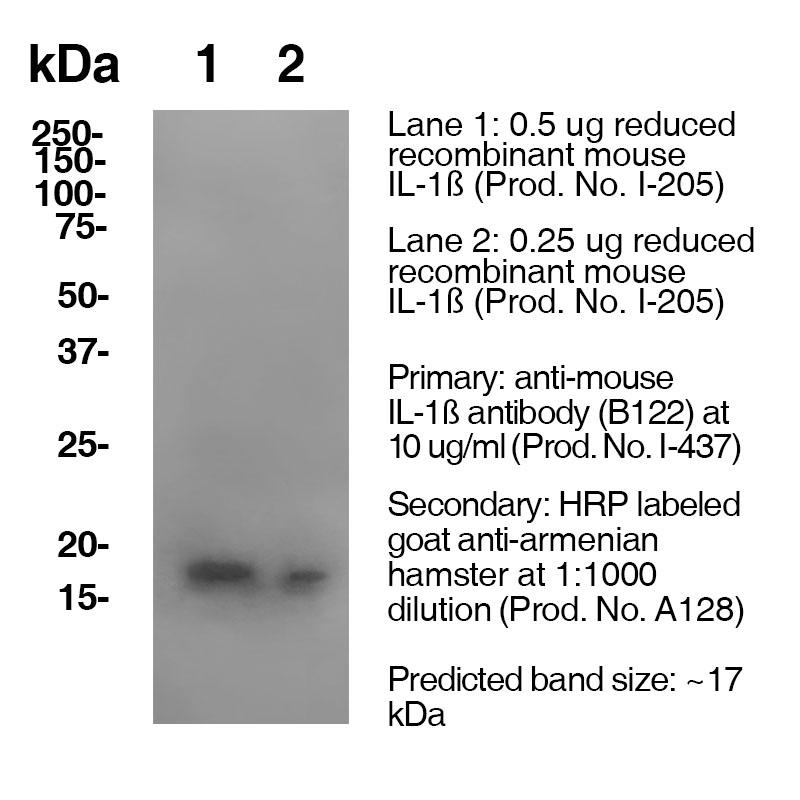Anti-Mouse IL-1β [Clone B122] — Purified in vivo GOLD™ Functional Grade
Anti-Mouse IL-1β [Clone B122] — Purified in vivo GOLD™ Functional Grade
Product No.: I-437
Clone B122 Target Interleukin-1 Beta Formats AvailableView All Product Type Monoclonal Antibody Alternate Names IL1B, IL-1, IL1-Beta, IL1F2 Isotype IgG Applications in vivo , IP , N , WB |
Data
Antibody DetailsProduct DetailsReactive Species Mouse Host Species Armenian Hamster Recommended Dilution Buffer Immunogen E. coli -expressed, recombinant mouse IL-1β Product Concentration ≥ 5.0 mg/ml Endotoxin Level < 1.0 EU/mg as determined by the LAL method Purity ≥95% monomer by analytical SEC ⋅ >95% by SDS Page Formulation This monoclonal antibody is aseptically packaged and formulated in 0.01 M phosphate buffered saline (150 mM NaCl) PBS pH 7.2 - 7.4 with no carrier protein, potassium, calcium or preservatives added. Due to inherent biochemical properties of antibodies, certain products may be prone to precipitation over time. Precipitation may be removed by aseptic centrifugation and/or filtration. Product Preparation Functional grade preclinical antibodies are manufactured in an animal free facility using in vitro cell culture techniques and are purified by a multi-step process including the use of protein A or G to assure extremely low levels of endotoxins, leachable protein A or aggregates. Storage and Handling Functional grade preclinical antibodies may be stored sterile as received at 2-8°C for up to one month. For longer term storage, aseptically aliquot in working volumes without diluting and store at ≤ -70°C. Avoid Repeated Freeze Thaw Cycles. Country of Origin USA Shipping Next Day 2-8°C RRIDAB_2737541 Additional Reported Applications For Relevant Conjugates ? N For specific conjugates of this clone, review literature for suggested application details. Each investigator should determine their own optimal working dilution for specific applications. See directions on lot specific datasheets, as information may periodically change. DescriptionDescriptionSpecificity Armenian Hamster Anti-Mouse IL-1β (Clone B122) recognizes Mouse IL-1β. This monoclonal antibody was purified using multi-step affinity chromatography methods such as Protein A or G depending on the species and isotype. Background Interleukin 1 beta (IL1 beta) is a proinflammatory cytokine belonging to IL1 family that is synthesized as a precursor. The IL1 beta precursor form is not biologically active. It is expressed mainly by stimulated macrophages and monocytes.1,2 IL1 beta is known to be a mediator in inflammatory response and to be involved in a variety of cellular activities, proliferation, differentiation and apoptosis. It has been recently found that IL1 beta is a major cause of severe inflammation in the mouse model of Crohns disease which makes IL1 beta an important target for this disease.3. The B122 antibody has been reported to neutralize the bioactivity of natural or recombinant IL-1β. Antigen Distribution Monocytes, tissue macrophages, Langerhan cells, dendritic cells, T lymphocytes, B lymphocytes, natural killer (NK) cells and many other B cells, T cells, related monocytes Function Stimulates T cells, B cells, proliferation/activation of NK cells, fibroblasts, thymocytes, and glioblastoma cells NCBI Gene Bank ID UniProt.org Research Area Immunology . Innate Immunity Leinco Antibody AdvisorPowered by AI: AI is experimental and still learning how to provide the best assistance. It may occasionally generate incorrect or incomplete responses. Please do not rely solely on its recommendations when making purchasing decisions or designing experiments. Clone B122 is a monoclonal antibody primarily used to target mouse interleukin-1 beta (IL-1β) in in vivo mouse studies, most notably for cytokine depletion (neutralization of IL-1β activity in living animals). Key uses in in vivo mouse studies:
Other uses (not exclusive to, but also relevant in in vitro work):
Summary of in vivo use: The B122 antibody, commonly used for detecting and neutralizing mouse or rat IL-1β, is often paired with several other antibodies or proteins in the scientific literature, especially in sandwich ELISA and ELISPOT assays. The most commonly used partner antibody with B122 is:
Other commonly involved elements include:
Applications and co-proteins/antibodies reported (though these are more about assay formats than specific named antibodies):
In summary, the most explicit and frequent pairing in the literature is B122 with Poly5158 in ELISA or ELISPOT formats for IL-1β detection. These assays may also involve recombinant IL-1β protein standards and enzyme-conjugated detection systems. In more advanced or multiplex immunological assays, B122 could be used together with antibodies for other inflammatory cytokines or cell-type markers, tailored to the specific research question. Clone B122 is most commonly cited in scientific literature as a monoclonal antibody that neutralizes mouse and rat interleukin-1 beta (IL-1β). Its primary research applications involve interrogating the role of IL-1β in autoimmune and inflammatory disease models. Key findings from studies utilizing clone B122 include:
In summary, clone B122 is a validated reagent for IL-1β blockade in mouse studies, enabling detailed characterization of IL-1β-driven immune mechanisms and therapeutic evaluation in autoimmune and inflammatory models. Dosing regimens for clone B122 (anti-IL-1β) vary depending on the disease model and study design, but the most common approaches are:
Key differences across mouse models:
These regimens are typically referenced according to the disease type and desired pharmacodynamic effect, and variations may be adapted for specific experimental endpoints. References & Citations1. Goldberg, Diamond, et. al (2017); PLoS ONE 12(5): e0177142 Article Link 1. Dinarello CA et al. (1996) Blood 87: 2095 2. Yuan et al. (1993) Cell 75: 641 3. Shin Maeda et al. (2005) Science 4: 735 Technical ProtocolsCertificate of Analysis |
Related Products
Prod No. | Description |
|---|---|
I-968 | |
I-964 | |
I-966 |
Formats Available
Prod No. | Description |
|---|---|
I-968 | |
I-960 | |
I-961 | |
I-962 | |
I-964 | |
I-966 | |
I-436 | |
I-437 |
 Products are for research use only. Not for use in diagnostic or therapeutic procedures.
Products are for research use only. Not for use in diagnostic or therapeutic procedures.



